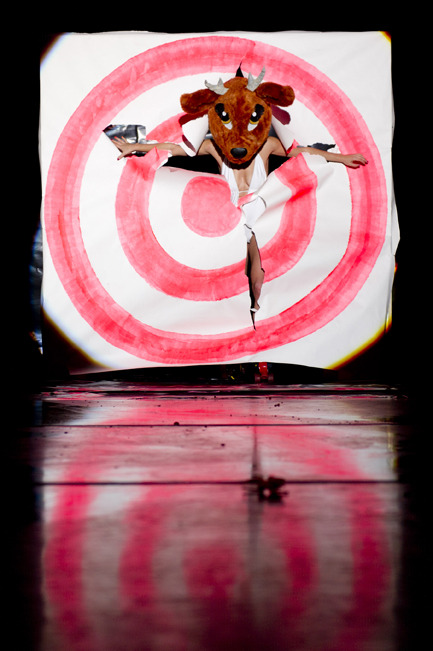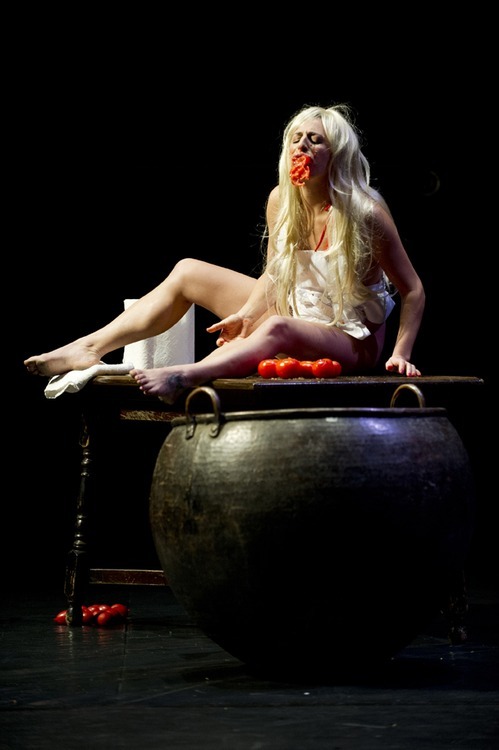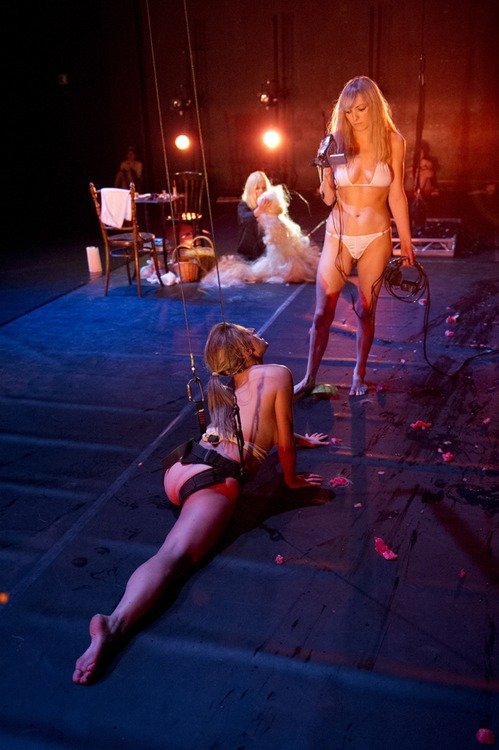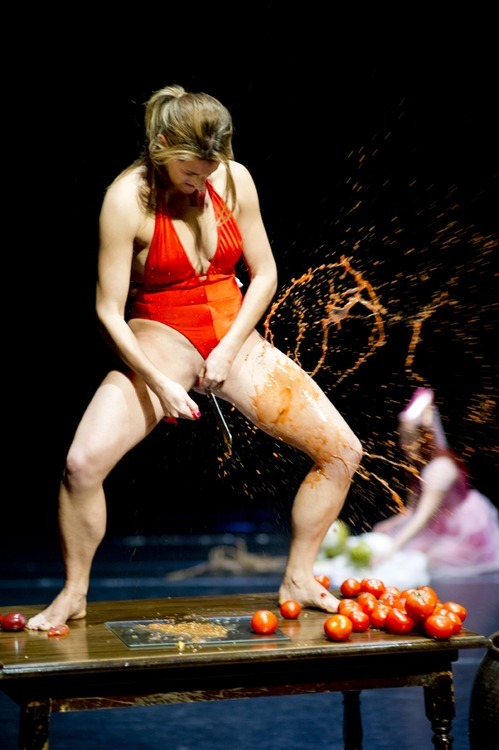By Rachel Lois
Mary and I have just finished a text on NOTA for Contemporary Theatre Review's (CTR) Intervention series, commissioned to sit alongside CTR's special issue on 'Editing' (25.1). The text features a selection of notes from our performance of NOTA at Cross-Cultural Live Art Platform, curated by Something Human, at the Proud Archivist in London, November 2014.
Johanna Linsley of the CTR Editorial team on NOTA in the context of the Intervention series:
'Alongside these features on editing, we also offer reflections from two different projects that deliberately subvert or refuse the edit. Both projects deal with performance documentation – NOTA is a performative intervention that occurs alongside performance events and explores notation, while Emergency Index is an annual compendium of performance documentation submitted by artists. As well, both projects toy with a utopian idea of unmediated response, while complicating this idea with attention to mechanisms like administration and design. Questions of labour, funding and independent or autonomous production also connect NOTA and Emergency Index, and add complexity to the wider discussion of what it means to not edit. Finally, while each is situated firmly IRL (in real life), they nevertheless explore a kind of radical indeterminacy that might be considered ‘virtual’.'
The text and images are online here
NOTA: NOT, NOTES, NOTER (NOTA), NOT/A, is a research framework produced by Open Dialogues (Rachel Lois Clapham and Mary Paterson) that presses on the time, place and quality of notes in relation to performance. Read more about this long term project here and here.
Friday 13 February 2015
Tuesday 10 February 2015
Lemonade xeverything was so infinite. by LemonMelon
Image C. LemonMelon 2015
Cixous's translation of Kafka's sentence 'Lemonade xeverything was so infinite.' forms the basis of a series of seven titles written by seven different writers / artists – David Berridge, Julia Calver, Emma Cocker, Rachel Lois Clapham, Marit Münzberg, Tamarin Norwood and Mary Paterson.
Each title explores one of the seven segments of this sentence – 'Lemonade', 'x', 'everything', 'was', 'so', 'infinite', '.'.
Using a variety of apparatuses and improvisational techniques Douglas Benford, Steve Beresford,Blanca Regina and Manuela Barczewski will play a selection of pages of the combined publication.
More information about the publication, and to purchase a copy, here
Tuesday 25 February 2014
NOTA Chapter 1 launch at I'm with you: INDEX
NOTA Chapter 1 launch at I'm
with you: INDEX
28 February, 7.30 - 11.00
] performance s p a c e [
Swan Wharf, 60 Dace Road E3 2NQ
] performance s p a c e [
Swan Wharf, 60 Dace Road E3 2NQ
Image © Open Dialogues
Please
join us for I'm with you: INDEX, an evening of performances, videos and
texts that focus overtly on indexing, notation and script.
Here, Open
Dialogues will be launching Chapter 1 of NOTA, a collection of notes made inside
live performances. NOTA CHAPTER 1 will be assembled and launched on the night
alongside Emergency Index Vol. 2, a bible of performance art activity.
Artists on the night include:
Artists on the night include:
] performance s p a c e [, Brian Lobel, Season
Butler, Warren Garland + Josh Baum, Yoko Ishiguro, Eirini
Kartsaki, Open Dialogues, Justin Hunt + Johanna Linsley, Daniel Oliver
//
ABOUT NOTA
NOTA: NOT, NOTES, NOTER (NOTA), NOT/A, is a research framework
produced by Open Dialogues that presses on the time, place and quality of notes
in relation to performance. Chapter 1 is the first of ten publications to
accompany the work. It is a collection of time-stamped documents - handwritten notes,
absent-minded doodles and choreographic diagrams - that were NOTAted in
relation to SHOWTiME performance festival (Presented by Alex Eisenberg and John
Pinder (Present Attempt) at Rich Mix, London 2012), and includes a critical text by Rachel Lois and Mary of Open Dialogues on the subject of notes as the future of performance remains.
Chapter 1
will be assembled live on the evening of the
launch by Rachel Lois and Mary, bound by hand and finished with a unique
time-stamp. No two publications are the same.
Available for the special launch price
of £4.
ABOUT EMERGENCY INDEX:
This is a bible of performance art activity. And if you are, like I am, a believer in performance art and the value of this ephemeral art activity to change the hearts and minds and consciousness of people, then you need to have this bible in your life. The end. —Martha Wilson
We’ve been seeing performance art materialize around us, but without feeling that there was a context for such ideas. Artists have been doing such pieces for a long time without much recognition that in fact their ideas are related. Now, with Emergency INDEX, we get the sense of a magical secret shared among many artists. Emergency INDEX is a profoundly important publication. It guides us to a new place. —Robert Ashley
Emergency Index: http://www.emergencyindex.com/
I’m with you: www.imwithyou.me
This is a bible of performance art activity. And if you are, like I am, a believer in performance art and the value of this ephemeral art activity to change the hearts and minds and consciousness of people, then you need to have this bible in your life. The end. —Martha Wilson
We’ve been seeing performance art materialize around us, but without feeling that there was a context for such ideas. Artists have been doing such pieces for a long time without much recognition that in fact their ideas are related. Now, with Emergency INDEX, we get the sense of a magical secret shared among many artists. Emergency INDEX is a profoundly important publication. It guides us to a new place. —Robert Ashley
Emergency Index: http://www.emergencyindex.com/
I’m with you: www.imwithyou.me
Open Dialogues: http://www.opendialogues.com/
SHOW TiME: http://www.show-time.org.uk/
Monday 12 August 2013
NOTA: Oh Seminar
Oh Seminar is a three-day summer school at Villa Romana, Florence, which attempts to reconsider different pedagogical forms traditionally used in the production and transmission of knowledge.

For Oh Seminar September 2012, Open Dialogues presented NOTA; taking up position at a writing station within the Oh Seminar community and NOTAting the various performances and presentations as they happened. We also presented a performance lecture on NOTA and shared specially commissioned writing experiments with participants.
The cumulative effect of NOTA over the three days speaks of notes as a practice, and form of knowledge production.
The above PDF selection of individual NOTA documents is made by Oh
Seminar Curators Mirene Arsanios and Valerio Del Baglivo. It shows private notes made in proximity to seminar
delegates, vigorous marks made live and in public at the NOTA writing station,
and participant's scribbles made in the secluded Florentine gardens of Villa
Romana.
Special thanks to the NOTA: Oh Seminar commissioned artists Alex
Eisenberg, John Hall, Karen Christopher, Marit Muenzberg, Tamarin Norwood and Viccy Adams.
ABOUT
NOTA: NOT, NOTES, NOTER (NOTA),
NOT/A
presses on the time, quality and place of notes in relation to live performance
and is part of Open Dialogues’ ongoing exploration of writing and documentation
as a medium within the context of collaboration, liveness and public space.
Oh Seminar is a three-day summer
school which attempts to reconsider different pedagogical forms traditionally
used in the production and transmission of knowledge. Through a series of talks
and performances, the school will question fundamentally what it means to read,
write, discuss and listen in a pedagogical setting. Artists: Read-in Collective,
Open Dialogues, Grant Watson and Iacopo Seri. Curated by Mirene
Arsanios and Valerio Del Baglivo. Villa Romana Florence,
September 2012 www.villaromana.org
Sunday 16 June 2013
NOTAMOLESKINE: 16.06.13
Today is the last day of the New Performance Turku Festival.
Over the last four days the NOTAMOLESKINE community has been working with festival artists and audiences to make small talk, maps, Vines, Zeegas and ethnographic pieces based on the performances.
You can read our work on the NOTAMOLESKINE blog here. A public discussion about the festival - and our writing within it - will be held at Titanik Gallery at 6 today.
We hope you will continue to visit the NOTAMOLESKINE blog as new texts will be posted there by the NOTAMOLESKINE Fellows for up to another two weeks.
///
NOTAMOLESKINE is a community of 7 writers/artists creating critical responses from the New Performance Turku Festival and uploading them onto web and social media platforms.
Creating documents from inside festival performances on handhelds, laptops and notepads, and in that moment of creation looking away from the presented work, NOTAMOLESKINE embraces a unique trajectory in which notes, diagrams, interviews and essays made from live performance can be located on festival web and social media as stand-alone pieces.
The NOTAMOLESKINE community is Rachel Lois Clapham, Alex Eisenberg, Emilia Karjula, Venla Luoma, Maria Säkö, Miika Sillanpää and Tuuli Suhonen (NOTAMOLESKINE Associate).
See NOTAMOLESKINE documents in up-printed media in festival venues, on the festival blog, Facebook or follow @NPTurku with #NOTAMOLESKINE
//
NOTAMOLESKINE is produced by Rachel Lois Clapham as Open Dialogues with New Performance Turku Festival. It contributes towards NOTA, an Open Dialogues research framework pressing on the time, quality and place of notes in relation to performance.
Thursday 6 June 2013
NOTAMOLESKINE
by Rachel Lois
NOTAMOLESKINE is a
community of 7 writers/artists creating critical responses from the New
Performance Turku Festival and uploading them onto web and social
media platforms.
Creating documents from
inside festival performances on handhelds, laptops and notepads, and in that
moment of creation looking away from the presented work, NOTAMOLESKINE embraces
a unique trajectory in which notes, diagrams, interviews and essays made from live
performance can be located on festival web and social media as stand-alone
pieces.
The NOTAMOLESKINE community
will contribute to a real-time critical mass for the festival and form part of
a collaborative performance archive. The writing itself acts variously as prompt,
record and gift for artists and festival audiences alike.
The NOTAMOLESKINE community is Rachel Lois Clapham, Alex
Eisenberg, Emilia Karjula, Venla Luoma,
Maria Säkö, Miika Sillanpää
and Tuuli Suhonen (NOTAMOLESKINE Associate).
See NOTAMOLESKINE documents in up-printed media in
festival venues, on the festival blog,
Facebook or follow @NPTurku
with #NOTAMOLESKINE
//
NOTAMOLESKINE is produced
by Rachel Lois Clapham as Open Dialogues with New Performance Turku Festival.
It contributes towards NOTA, an Open Dialogues research framework pressing on
the time, quality and place of notes in relation to performance.
Open Dialogues is a UK
collaboration, founded in 2008 by Rachel Lois Clapham and Mary Paterson, that
produces critical writing on and as performance. Open Dialogues has pioneered a
model of working closely with performance and Live Art artists to critically
respond, document and influence the moment of live performance. Programme
partners include The Live Art Development Agency (UK), Pacitti Company (UK),
Trinity Laban (UK), Performa Biennial (US) and Performance Saga (CH) amongst
others. www.opendialogues.com
Sunday 3 March 2013
Review: SPLAT! by The Famous Lauren Barri Holstein
by Mary Paterson
A figure roller-skates blindly across the stage, her vision obscured by a giant deer mask, her arms flailing at either side, her voice singing karaoke-style to a Disney ballad. Half girl, half Bambi, the skidding ingénue slips and slides over tomato juice, topples, wavers and almost falls, before a team of assistants rushes to her aid.

This scene is one of a dizzying array of feminine stereotypes played outrageously by The Famous Lauren Barri Holstein in Splat! Here, she parodies a cutesy cartoon princess, held up (literally) by an entourage who whose devotion simply highlights her dependence on others. Elsewhere, the performer and her semi-naked, female assistants perform a range of roles including bad tempered porn star, mute doll, exploited sex object, fairy-tale narrator, murdered body and soppy victim of heartbreak.
For Lauren Barri Holstein, the acting starts before the show begins. ‘The Famous …’ is, of course, a self-declared star. What she is famous for is not important - her name, like the products of her visual metamorphoses, is both a statement and an ambition. And, just like those visual changes, this declaration is less a form of identity than a claim to objecthood. By describing herself as ‘The Famous …’ Lauren Barri Holstein sets out how she wants to be seen. She’s not a woman play acting at celebrity – she is the very expression of fame. She’s not a woman who happens to be dancing (whether she’s performing in the guise of a Disney lead, a figure from an 80s film, or a demented R&B star) – she is the eternal dancing girl.

Even the artist’s desperation to be seen is a kind of parody-paradigm of femininity . As John Berger wrote in 1976, “men act, women appear”, so controlling what other people see is, in a twisted way, how women can access the means of their own production. Lauren Barri Holstein struts across stage like an early-80s Madonna, adopting a bossy demeanour (she orders her assistants around like slaves), an air of affected boredom (she moves between scenes as if it’s a burden to be there) and a casual, erotic awareness of her own image-making.
But ventriloquism is a precarious kind of identity.
As part of this image control, Lauren Barri Holstein forces her parade of underdressed assistants to film her travails, projecting a close up of her squashing tomatoes between her thighs, for example, to a large screen at the back of the stage. But there is also a single, male, fully dressed photographer who lurks around the edges of the show. This man does not seem to be under the star’s control. He photographs Lauren Barri Holstein even when she asks him to leave, and his photos remain hidden inside his camera. In a single moment, the iconic 80s Madonna becomes a vulnerable noughties Jordan, her picture taken and reused by those who don’t recognise her objecthood as power.
Indeed, it’s the relationship between objecthood and power that sits at the centre of Splat! Or rather, it writhes around in a vat of tomato juice, either waving or drowning. With each new identity that Lauren Barri Holstein shrugs on like an invisibility cloak, Lauren Barri Holstein herself disappears. This is partly because of the dramatic pointlessness of the task – it is of course a mainstay of feminism that a person cannot exist within a series of roles typecast from the outside. But the disappearance is also because the accumulated effect of multiple identities breaks down the mirage of appearance itself. Now a sexual predator, now a perpetrator of misogyny, now a fetish of desire, the variety of objecthoods Lauren Barri Holstein puts on display undermines any claims they have to representation. If a woman is either a virgin or a whore, then what are you looking at when you see her slip gracelessly between the two?

Another way of describing this variety could be as a kind of excess - Splat! is an excess of (tropes of) femininity, baring their bones until their guts spill, lifeless, onto the floor. And excess is indeed the defining principle of the show: each scene explodes with more bodies, more representation, more confusion.
But, inside Splat, excess becomes a kind of trope as well. Or, more accurately, this excess is not so much excessive, as conventional – albeit conventional in an alternative, performance art kind of way. The food-mess poured over young bodies recalls the artist Carolee Schneemann’s seminal performances like Meat Joy (1964)for example, while Lauren Barri Holstein’s impatient persona draws obvious comparison to the artist Ann Liv Young. Long passages in Splat are spent reading an alternative fairy tale in which a pliant female character explores the pleasures and dangers of her sexuality – a shadow, perhaps, of a revision by the feminist author Angela Carter.
In this context, it’s unclear whether excessive behaviour is being parodied as one more feminine trope that has been normalised beyond meaning, or whether it’s appearance is a genuine grab for power.
On one hand, these behaviours are now part of the encyclopaedia of voices available to women – identify with a pop star, or a princess, or a 1960s performance artist. But, just like Madonna’s 80s attitude, their efficacy has been dulled by distance from the socio-political context in which they were conceived. On the other hand, these devices of excess have a special status within Splat!: they define its structure and limit its content. Food-blood-bodily fluids accumulate onstage throughout, the fairy tale pulls the only narrative thread, and each new scene adds to a catalogue of excessive representations. As I watch the chaos pile up on stage, I wonder if Lauren Barri Holstein is making fun of the styles of radical feminist performance art, with the same wide eyed cruelty she uses to pull apart Disney’s saccharine charm. Or has she mistaken the tropes of stylistic excess for real power?

None of Lauren Barri Holstein’s relationships are simple. She seems to hold genuine affection for power ballads, princess dresses and roller-skating Bambis, even while she squashes their dreams like melons dropped from a great height. So perhaps it is only my prejudice that imagines she takes the sacred cows of performance art too seriously. Unlike Disney, I hold Carolee Schneemann to be important and admirable, and while I can laugh at Disney in almost any context, Schneemann commands a different kind of attention. But I also know that what was radical in 1964 is not radical in 2013; the grandmothers (or even the aunts and sisters) of feminist performance art cannot be copied, only revised. I long for someone with a name like ‘The Famous Lauren Barri-Holstein’ to tell me what feminism can be, what women can be, in the twenty first century.
But of course, that’s not her job. I’m sure if you asked her, Lauren Barri Holstein would say she’d rather hang upside down and eat a hamburger. The show ends with what can only be described as a masterstroke of visual spectacle, and it’s at moments like this – brash, bizarre and fiercely independent – that ‘The Famous …’ lives up to her self declared name.
Labels:
critical writing,
lauren barri holstein,
live art,
mary paterson,
review
Subscribe to:
Posts (Atom)











